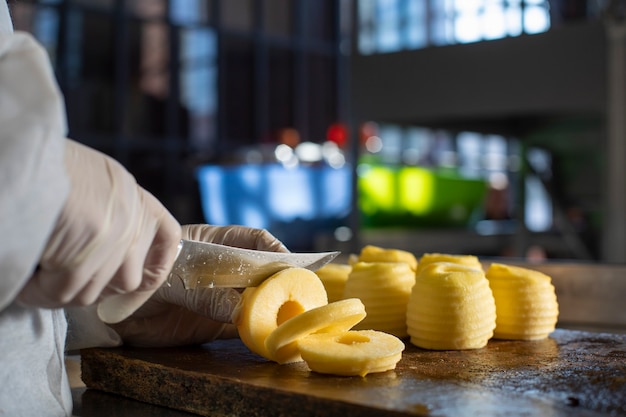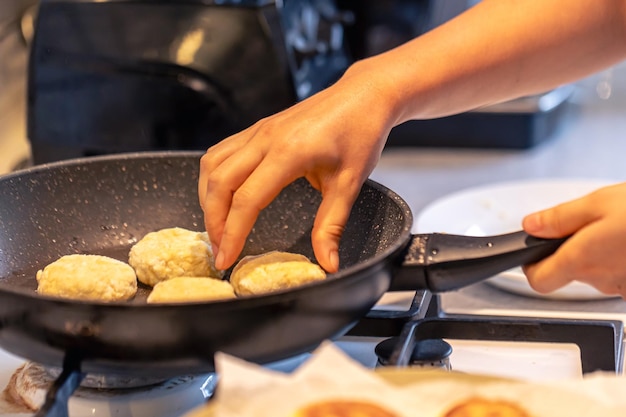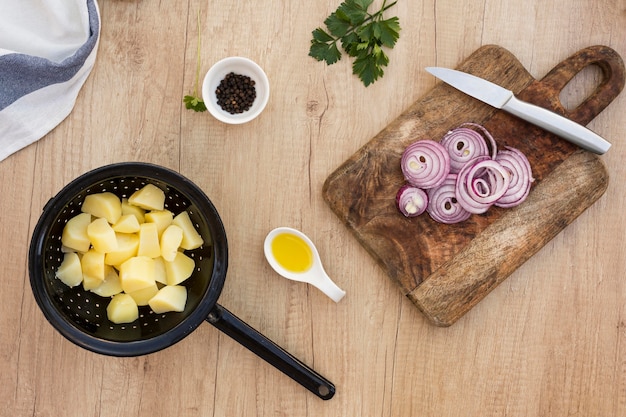Let's be honest, we all love a good baked potato, right? It's comforting, versatile, and a perfect canvas for endless flavour combinations. But, sometimes, nailing that perfect baked potato can feel like a culinary mystery. How long do you bake it for? How do you know when it's done? Fear not, my fellow potato enthusiasts, I'm here to demystify the art of baking a potato to perfection.
I've been baking potatoes for years, experimenting with different techniques and varieties, and I've learned a thing or two along the way. From choosing the right spud to mastering the oven temperature, I'm going to walk you through the process step-by-step, making sure you're armed with the knowledge to achieve potato-baking greatness.
(Part 1) The Great Potato Debate: Choosing the Right Spud

First things first, we need to talk about the potato itself. You wouldn’t use just any flour for a cake, would you? So, selecting the right potato is crucial for baking success. While there are many varieties out there, I firmly believe that the humble maris piper is the king (or queen, depending on your perspective) of baking potatoes.
Why Maris Piper Rules the Roost:
Superb Shape Retention: They bake up beautifully, maintaining their structure rather than crumbling into a mushy mess.
Fluffy Interior: The flesh becomes delightfully fluffy and airy, making it perfect for topping with butter, cheese, or any other delicious additions.
crispy skin: The skin develops a lovely golden brown crispness, adding a textural contrast to the soft interior.
Other Potato Contenders:
king edward: These potatoes are known for their sweetness and creamy texture. They bake a bit quicker than Maris Piper, so you might need to adjust your baking time.
Desiree: A versatile potato with a firm texture that holds up well in baking. They can be a bit denser than Maris Piper, so you might need to bake them for a bit longer.
Russet: This is a popular choice for baked potatoes in the US. They have a starchy texture and tend to bake up fluffy and dry.
The Garden Variety:
Don’t shy away from experimenting with potatoes from your own garden! Different varieties will have different baking times, so you might need to experiment a bit.
(Part 2) Setting the Stage for Success: Preparing Your Potato

Just like any culinary masterpiece, a perfect baked potato requires a bit of preparation. It's all about getting that spud ready to shine in the oven.
A Thorough Scrubbing:
Before we get started, make sure your potato is clean. Give it a good scrub under running water, using a vegetable brush to remove any dirt or debris clinging to the skin.
For extra TLC, you can soak the potato in cold water for 30 minutes before baking. This helps prevent it from drying out too much.
A Few Strategic Piercings:
Now, it's time for a little bit of poking. Use a fork to pierce the potato a few times. This allows steam to escape as the potato bakes, preventing it from exploding in the oven (a truly unfortunate event that has happened to me, believe me!).
You don’t need to go overboard – a few well-placed holes will do the trick.
A Touch of Oil and Spice:
Once your potato is scrubbed and pierced, a light drizzle of olive oil is a good idea. This helps create that lovely golden-brown colour on the skin and prevents it from sticking to the baking sheet.
For a flavour boost, feel free to add some herbs and spices. Rosemary and thyme are classic combinations, but you can also experiment with paprika for a little kick, garlic powder for a savory note, or even a sprinkle of smoked paprika for a more complex flavour profile.
(Part 3) The Oven: Your Baking Partner in Crime

Now, let's talk about the oven, your trusty sidekick in this potato-baking adventure. You need to know your oven’s quirks to ensure a successful baking experience.
The Importance of Preheating:
Before you even think about putting your potato in the oven, preheat it to 200°C (400°F). This is crucial for ensuring even cooking and preventing the potato from ending up raw in the middle.
I’ve learned the hard way that oven temperature fluctuations can really make a difference in the outcome of your baked potato.
Rack or Sheet: The Great Baking Debate:
You can bake your potato directly on the oven rack or on a baking sheet. Personally, I prefer the rack, as it allows for better air circulation and a crispier skin.
However, if you’re baking multiple potatoes, a baking sheet is a good choice, as it provides a more stable platform and prevents them from rolling around.
(Part 4) The Baking Process: A Lesson in Patience
Now comes the waiting game. Baking a potato is about more than just time – it’s about understanding the potato's signals.
Time as a Guide:
A medium-sized Maris Piper potato will typically take 50-60 minutes to bake.
However, different potato varieties have different baking times, so you might need to adjust based on the type of potato you’re using. The table in (Part 1) offers a general guide.
Feel as a Sign:
When the potato is ready, it will feel quite firm to the touch, but will yield slightly when you press it.
If you poke it with a fork, it should go in easily. If you need to use a lot of force, it needs a few more minutes in the oven.
The Importance of Patience:
I know it’s tempting to check on your potato every five minutes, but try to resist the urge. Opening the oven door too often disrupts the heat and can slow down the baking process.
Give your potato at least 45 minutes of undisturbed baking time before you start poking and prodding.
(Part 5) The Finish: Letting the Potato Rest
Once your potato is cooked, it's not ready for topping just yet. It needs a little time to rest and absorb all that delicious steam.
The Power of Rest:
Let the potato rest for about 10 minutes before cutting it open. This allows the steam to redistribute, creating a fluffy, moist interior.
The Grand Reveal:
Now, carefully cut the potato open. You should be greeted with a beautiful, fluffy, white interior.
If it’s a bit wet, pop it back in the oven for a few more minutes.
(Part 6) The Art of Topping: A Symphony of Flavours
You’ve got a perfectly baked potato. Now it's time to unleash your creativity.
The Classic Combinations:
A good dollop of butter is a must-have for any baked potato.
Salt and pepper are essential to enhance the natural potato flavour.
A generous spoonful of sour cream or Greek yogurt adds a tangy contrast to the richness of the butter.
Beyond the Basics:
For a fresh, herbaceous touch, try chopped chives or spring onions.
Adding crumbled bacon or cheese for a more savory flavour is always a good idea.
For a healthy and satisfying option, go for a dollop of avocado and a splash of salsa.
sweet potato Delights:
sweet potatoes are a delicious alternative to regular potatoes. Their natural sweetness makes them perfect for a variety of toppings.
Try adding a drizzle of maple syrup, chopped pecans, and a dollop of whipped cream for a decadent treat.
(Part 7) Baking Beyond the Basics: Expanding Your Potato Horizons
Baked potatoes are so versatile, they can go beyond being a mere side dish.
Potato Skins:
For a delicious appetizer, try making potato skins. Bake the skins until they're crispy, then scoop out the flesh and fill them with your favourite toppings.
Cheese, sour cream, bacon, and chili are all great options.
Stuffed Potato Perfection:
For a hearty and satisfying meal, stuff your baked potato with a variety of fillings.
Popular choices include chili, cheese and bean mixtures, tuna salad, or even a vegetarian filling with roasted vegetables and quinoa.
(Part 8) The Never-Ending Quest: Tips for Success
I’ve learned a few tricks along the way that can help you avoid common potato-baking pitfalls.
Avoid Overcrowding:
If you're baking multiple potatoes, give them enough space to breathe. Overcrowding the oven can lead to uneven cooking.
The Baking Sheet Trick:
If you're worried about your potato sticking to the oven rack, bake it on a baking sheet. A parchment paper liner can prevent sticking and make cleanup a breeze.
Embrace Experimentation:
The beauty of baked potatoes is that they’re so adaptable. Don’t be afraid to experiment with different toppings and fillings. You never know what delicious combinations you might discover.
(Part 9) The FAQs: Answering Your Burning Potato Questions
I get asked all sorts of questions about baking potatoes. Here are a few of the most common ones:
1. Why does my potato always explode in the oven?
This usually happens when the potato gets too hot inside and the steam has nowhere to escape. Make sure to pierce the potato with a fork before baking to allow the steam to vent safely.
2. How do I know if my potato is done?
The best way to tell is by gently pressing it. If it feels firm but yields a little, it’s ready. You can also test it with a fork – it should go in easily.
3. Can I bake potatoes in the microwave?
You can! It's faster, but the skin won't be as crispy as with oven baking.
4. What happens if I overbake my potato?
It will become dry and crumbly. Wrap it in foil and let it rest for a few minutes to rehydrate it.
5. What are the best toppings for baked potatoes?
It’s all about your taste! Popular choices include butter, sour cream, cheese, chili, bacon, chives, and avocado.
I hope this guide has provided you with the knowledge and confidence to bake the perfect potato, every time. Now go forth and create some culinary magic! Remember, it’s all about experimentation and having fun in the kitchen.
Everyone is watching

Prime Rib Roast Cooking Time Chart: Per Pound Guide
Cooking TipsPrime rib roast. Just the name conjures images of lavish dinners, crackling fires, and hearty laughter. It’s ...

How Long to Bake Potatoes in the Oven (Perfect Every Time)
Cooking TipsBaked potatoes are a staple in my kitchen. They're incredibly versatile, delicious, and surprisingly easy to m...

Perfect Rice Every Time: The Ultimate Guide to Cooking Rice
Cooking TipsAs a self-proclaimed foodie, I've always been a bit obsessed with rice. It's the foundation of countless cuisi...

The Ultimate Guide to Cooking Asparagus: Tips, Techniques, and Recipes
Cooking TipsAsparagus. The mere mention of this spring delicacy conjures up images of vibrant green spears, crisp and burs...

Ultimate Guide to Cooking the Perfect Thanksgiving Turkey
Cooking TipsThanksgiving. Just the word conjures up images of overflowing tables laden with delicious food, the scent of r...
